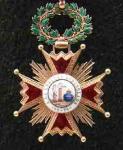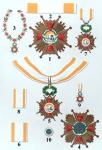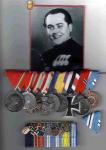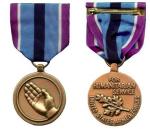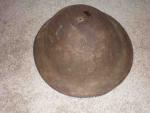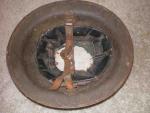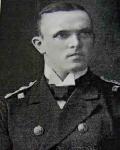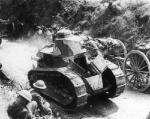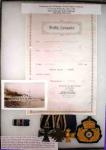
army historian
For Deletion-
Posts
1,543 -
Joined
-
Last visited
-
Days Won
3
Content Type
Profiles
Forums
Blogs
Gallery
Events
Store
Everything posted by army historian
-
Very nice thanks, Cheers Captain Albert
-
I just went over the photo again - Yes this is a very odd assortment - no usual for the Germans. It is possible that since none of the Germans has a weapon - and the French policeman is wearing a Sam Browne belt (he could be armed), they might be prisoners. The French Adrian, and French Fire fighter, helmets along with the Odd side cap (French or Russian?) just does not fit with serving soldiers. One other point, what is with the shako? Is it French? Also did anyone notice to the right of the gendarme there appears to be a person (cut off the photo) - that appears to be wearing a white US Helmet or Helmet liner like a US Military Policeman? I think the photo is 1944 or later and this assortment of Germans are prisoners - and happy to be out of the War. A couple don't look happy - and the German in the back of the photo doesn't have any head gear on. Also the two Germans in front are wearing East Front ribbons (not one). Cheers Captain Albert
-
Does anyone know if this book, or the section on the Cruisers in Foreign Waters was ever reprinted in English? As close as I can come to the title is: The Ocean War 1914-1918. Navy archive (ed.) : .The Cruiser war in the foreign waters. 1st Bd.: The Kreuzergeschwader. Berlin: Mediator, 1922 Thanks Captain Albert
-
Austria-Hungary Silver Merit Cross with crown
army historian replied to Tim B's topic in Austro-Hungarian Empire
Can some one please tell us what is the difference between the Silver and gilt Merit Crosses one with no enameled centers and the ones with the while enameled Centers? Which type was issued in WW1? Thanks Captain Albert -
Austria-Hungary A-H Field Gray Infantry Captains Uniform
army historian replied to hunyadi's topic in Austro-Hungarian Empire
Great tunic - thanks for showing Cheers Captain Albert -
Yes this is a very odd assortment - no usual for the Germans. It is possible that since none of the Germans has a weapon - and the French policeman is wearing a Sam Browne belt (he could be armed), they might be prisoners. The French Adrian, and French Fire fighter, helmets along with the Odd side cap (French or Russian?) just does not fit. One other point, what is with the shako? Is it French? Cheers Captain Albert
-
Bundesrepublik Einsatzmedaille Gefecht
army historian replied to Elvis's topic in Germany: Post 1945: Bundesrepublik & DDR
So is this like getting an Iron Cross now? Nice medal Elvis. Cheers Captain Albert -
My British Collection
army historian replied to Hauptmann's topic in Great Britain: Orders, Gallantry, Campaign Medals
Wow, very nice research project - you saved an India Mutiny Medal's Identity, and verified the owner (from a very heavily engaged Crimean War Regiment). What bars was he entitled to on the Crimea? Congratulation Captain Albert -
Murder most foul?
army historian replied to Chris Boonzaier's topic in Great Britain: Research, Documentation & History
I believe this is a very valid point. The French Navy could not be allowed to hook up with the Axis Navies, especially in the Mediterranean. also Look at what happened in the Invasion of North Africa - The French decided to fight the Allies. So I believe this is a mute point. The British were totally justified, and very smart to do this. The contention of no Actual War existing is not valid, as the French had already been conquered by the Germans - So their status as combatants was not clear, but could be assumed to be controlled by the Axis. Which North Africa proved later. Also remember that before 1941 the Russians had non-aggression treaties with Hilter, so Russia was not an Ally. This was a grim period for England, with "The Battle of Britain" going on. Cheers Captain Albert -
Hungary Hungary - WW2 medals
army historian replied to Mossy's topic in Central & Eastern European States
Hello all, I have this WW2 Hungarian group to Sergeant Major Vitez Zoltan David. His awards: Order of Vite’z Bar: Large Silver Bravery Medal (Horthy) Small Silver Bravery Medal (Horthy) Fire Cross with swords 1942 Fire Cross without swords Liberation of Upper Hungary Medal Yugoslavia Campaign Medal 1939 Iron Cross 2nd Class and 1957 version German East front Medal Royal Canadian Life Saving Society Silver Benefactor Medal Royal Canadian Life Saving Society Bronze Benefactor Medal Royal Canadian Life Saving Society Silver Jubilee Medal Royal Canadian Life Saving Society Alberta Branch Diamond Jubilee Medal Cheers Captain Albert -
Weimar Period Long Service
army historian replied to army historian's topic in Germany: Weimar Republic & Deutsche Freikorps
Wow, I did not know Colonial and Sea time counted double. That really explains a lot. Thanks very much Captain Albert :cheers: -
Weimar Period Long Service
army historian replied to army historian's topic in Germany: Weimar Republic & Deutsche Freikorps
Thanks, Paul. That makes sense, but why so many 25 year crosses without 1897 Centennial medals? Did War time service count double (like retirement)? Cheers Captain Albert -
Harvey, I probably should stay out of this (Got my butt chewed by a Colonel - for saying I hated the design of the US Humanitarian Service Medal [i earned twice] and wore with the reverse to the front - because I hate the "Hand"). But that said I believe first of all that US medals produced since sometime in the late 80s or early 90s are very poorly made, and second the designs (since the Vietnam Service Medal) have little or no style. I think the sort of frosted finish they now use is part of the problem. I feel bad for our troops, that more attractive medals could not be designed. This is just an observation on my part, and definitely has not a thing to do with the troops God bless them. Respectfully Captain Albert
-
EK 1914 My Imperial 2nd Classes
army historian replied to Hauptmann's topic in Germany: All Eras: The Iron Cross
The damaged crosses can be repaired, especially the bummed up ring. A jeweler can do it relatively cheap. Or you could use a wooden dowel of appropriate size and slowly round it out (check Restoration section). Otherwise a nice respectful collection of EKs. Thanks for shearing. Cheers Captain Albert -
Hello all. Since the Weimar Republic had no official long service awards - what did serving personnel wear when they reached 15, 20, 25 years long service during this period. Did they wear imperial long service awards, or do without? This has always intrigued me. From a lot of bars - it appears to me they wore Imperial awards, until the Nazis came along (and some wore Nazis awards). Is this a correct assumption? Thanks Captain Albert
-
Just picked up today WW1 US Helmet & Breeches
army historian replied to army historian's topic in United States of America
Thanks Hauptman, yes this little store (hole in the wall) has produced a light chocolate colored WW1 tunic, female Lt. Health Service uniform (complete), 2 - WW2 US Naval Lt. tunics to name a few. I don't usually list prices but in this case I got both for $50.00. A very good find. I have been trying to work with her, so she will let me know when she has something. She told me a "collector" thought that $40.00 for the helmet was too much. I found that a little surprising. He either did not have much money or was trying to get it for near nothing. I guess some people are in this only for the "kill". Here's hoping you have some luck in local finds. Cheers Captain Albert :cheers: -
Kovetten Kapitan Franz-Christoph Schroeder Born 1879 died 1925 at the age of 46. He entered the navy in 1896. His first service was on the S. M. S. Stosch training ship. He was awarded the Prussian Silver Lifesaving medal on 7 September 1902. Schroeder served on the S. M. S. Stosch, S. M. S. Nixe, S. M. S. Charlotte, S. M. S. Mars (Artillery Training Ship), S. M. S. Beowulf (Coastal Defense Ship), and S. M. S. Hildebrand (Coastal Defense Ship). He served on S.M.S. Charlotte in 1902/03 during the Veneszula Blockade, earnig the Colonial Medal with "Veneszula 1902/03" bar. Schroeder served on the S. M. S. Charlotte for the period of April 1901-1903. The cruise begins in Wilhelmshafen and Kiel. Places visited during this period were Petersburg, Bilbao, Madeira, Sandos, Montevideo, Trinidad, etc. He was then transferred to the S. M. S. Hertha Flagship of the East Asiatic Squadron. We see that this vessel made calls at Nagasaki, Tsingtau, etc. Form 1903 to 1905 he served with Prince von Prussian Adalbert on S.M.S. Hertha in China (Midshipman Koehler was also on the Hertha at this time), and at the II Torpedo Division in Kiel (see photo of .Prince von Prussian Adalbert with dedication). In 1905 Schroeder was under special orders of the Kasier and sent to Istanbul Turkey (see pass). During this time he earned the Turkish Order of Osmanie 4th Class, and Türkish Silver Imtiaz Medal. He was next transferred to the S. M. S. Loreley. Following that, he was assigned to the S. M. S. Leipzig for the period of 1906-1907. [Aboard this ship he mentions that the kommandant is a Fregattenkapitän Hipper. In 1910 Rangsliste pg 230 – listed 18/116 Kapitan Lieutenant U officer on BB S.M.S. Wettin circle R, SK4, TsM, TO4. His medal bar is as follows: Full sized Medal Bar: 1914 Iron Cross 2nd Class Prussian Life Saving Medal Prussian Order of the Red Eagle 4th Colonial Medal bar Venezuela 1902/03 S.M.S. Charlotte 1897 Centennial Medal Mecklenburg-Schwerin War Merit Cross 2nd Class (MMV2) Oldenburg Friedrich August Cross 2nd Class Prussian Officer's service cross Siam Order of the Crown 4th Class Turkish Order of Osmanie 4th Class Turkish Silver Imtiaz Medal Breast Badges: 1914 Iron Cross 1st Class Oldenburg Friedrich August Cross 1st Class Since I am still researching Schroeder I would appreciate any help (rangslist, etc) for the periods after 1907 (except 1910). I do not know if Schroeder stayed in the Navy after WW1. I also do not know what he died of in 1925 (and if he was still in the service). Thanks in advanced, and Cheers Captain Albert
-
Jason, sorry for not replying sooner. Here is what I have on Ochel. Cheers Captain Albert Lieutenant d.R. Robert Otto Ochel, Baden Lieb Grenadier Reserve Infantry Regiment (RIR)109, 28th R Div. Hohenzollern House Order awarded 14 June 1917, Baden Order Of The Zähringer Löwen GMIC: Deruelle joined 15-May 05 (From Baden) Posted 19 May 2005 Hi Have a look about these items and photo from a beautiful Leutnant with EK2 One group belonged to Leutnant Ochel from R.I.R Nr. 109: photo, document, lose medals, ribbon bar (This officer received :EK2, EK1, HHO3X, BZ3bX), Feldbinde, Collar tabs, and shoulder boards, and certificate Hohenzollern House Order with swords awarded 14 June 1917. GMIC: Deruelle,joined 15-May 05, Same group post: (History On a Bar: Any Bar Show your ID'd medals), Posted 25 November 2006: One group belonged to Leutnant Ochel from R.I.R Nr. 109: photo, document, lose medals, ribbon bar, Feldbinde, Collar tabs, and shoulder boards. GMIC: Bayoswede (What kind of Rgt is this) Posted 01 September 2007: “One 109th Badisher to the collection.” Probably from Deruelle. GMIC Noor (Timo Tamme) Joined: 15-March 07 (Noor’s Ribbon Bars): Posted 17 January 2010: Leutnant d.R. Robert Otto Ochel RIR No. 109 (Baden) ribbon bar, photo, veteran badge, and Hohenzollern House Order Certificate. I traded Timo my 1st Lieutenant James C. Pitts (Spanish American Cal Guard Group from Yas) for Leutnant d.R. Robert Otto Ochel RIR No. 109 (Baden Leib Grenadier) ribbon bar, photo, Very nice 109th Veteran badge and Hohenzollern House Order Certificate on 18 June 2010. Sent package 23 June 2010 registered. Lieutenant der Reserve Robert Otto Ochel in the Reserve Infantry Regiment (RIR) 109 This officer received: EK2 EK1 HHO3X BZ3bX 1934 Combatants Cross (was alive in 1936) In WW1 - 8,300 Hohenzollern House Orders were awarded. It was usually award after the 1st Class Iron Cross was awarded. 1st and 2nd Battalions RIR 109th were authorized collar Lit-Zen, and Swedish cuffs same as Infantry Regiment 109. Battle of the Somme Some of you may know that I have been compiling a comprehensive list of all possible German losses for 1 July 1916. By far the heaviest losses are associated with the areas of fighting where it was particularly deadly such as Thiepval and especially further south between Mametz, Montauban and Curlu. Losses in the regiments of the 28th Reserve Division, 12th Division and the 6th Bavarian Reserve Regiment are by far the heaviest and they fought in the sectors where the greatest progress was made by the French and British troops that were attacking. In an associated matter, I once brought up the disparity of the official loss report used by some regiments and the actual numbers once the details were checked. This is especially important when looking at loss numbers for regiments like RIR 109 (28th Reserve Division, Montauban Sector). The regimental account used the initial loss return to portray the losses suffered by the regiment. The numbers are: Killed: 14 officers, 94 Other Ranks Wounded: 6 officers, 261 Other Ranks Missing: 24 officers, 1,749 Other Ranks Total 44 officers, 2,104 Other Ranks. This is a correct assessment of the losses suffered by the regiment and the loss returns taken after a particularly bad day of fighting. It is however the initial loss report and as such did not contain much of the information needed to adequately determine the fate of the numerous missing officers and men. In my initial review of RIR 109 I was able to track down the fate of many of the missing officers and men and obtain a more accurate portrayal of the actual losses suffered by the regiment. I found that the number of men killed, 108 in all was actually far higher when the first list and subsequent loss lists were reviewed. 17 officers and acting officers were killed plus at least 533 Other Ranks that were killed or died from wounds; including 23 men who died of wounds while a prisoner of war. This means at least 550 officers and men died on 1 July or from wounds received on that date and not the 108 from the original report. Most of the other MIA were prisoners of war as can be seen in the Malins film as they are marched to the rear. Generalmajor SCHERENBERG Died on 14 June 1917 at Warmeriville (France) from wounds received on 8 June 1917 in battle at Reims. General Scherenberg was Commander of the 231. Infantry Brigade when he was wounded. Posted Ochel on GMIC got reply from Glenn J. 25 Aug 2010 “Robert Ochel survived the war and is listed as an Oberleutnant d.R. a.D. in the Members' List of the Officers' Association of the Baden Leibgrenadier-Regiment in October 1936. He is shown as the proprietor of the Bankgeschäft Robert Otto Ochel of Essen, Heinickestraße 9 and with a date of birth of 13 July 1885. He was originally commissioned into 7. Bad. Infanterie-Regiment Nr. 142 on 27.1.13.” (27 Jan 1913) Traded Ochel plus cash for Kovetten Kapitan Franz-Christoph Schroeder (7) ribbon bar, paperwork, photos, and and two diaries. 30 Aug 2010. This is a great deal, from Der Rittesmiester. <br style=""> <br style="">
-
Photos of tanks from the Great War
army historian replied to Freiwillige's topic in The Great War 1914 to 1918
-
Show your "boom!" photos!
army historian replied to The Prussian's topic in Armour, Vehicles, Ships & Aircraft
-
I should of added this small group to Dr. Georg Warnecke crew of 06, who served on the S.M.S.Karlsruhe. Dr. Georg Warnecke crew of 06. Born 04 May 1884 in Schleswig. Studies in Frieburg 1903. 1903/04 in Leipzig math and science, then medicine 1904 in Leipzig, 1904-1906 Jena, 1906 Marbug, 1906/07 Berlin, 1907-1909 Kiel. 18 Jan 1909 States examination 01. Arpil 1906 one year volunteer 01. Feb 1910 one year volunteer navy doctor 22. Jul 1910 promoted to navy doctor Commissions: 28. Sep 1910 as a "Marine Assistent Arzt" 14. Oct 1911 "Marine Ober Stabs Arzt", 22. Mar 1913 commissioned Marine Stabsarzt (all three analogous to Ensign, Second Lieutenant, First Lieutenant ) War Service: At the start of the war, He was the Ship's doctor of the light Cruiser S.M.S. Karlsruhe, which, after capturing or sinking 76,609 (I have 65,567) registered British tons, (exploded and) sunk at 10 degrees, 7 minutes N and 55 degrees 25 minutes W. Warnecke was picked up by the "Rio Negro" and returned to Germany on 6 December 1914. He was awarded the Iron Cross 2nd Class in December 1914. In Jan. 1915 he was assigned to the III. Battalion of the 3rd Matrosen Divison (land based sailors)(also reported as I Battalion). In Oct. 1915, he was the Ship's doctor on the light Cruiser S.M.S. Stralsund. In Sep 1917 He was Placed at the disposal of the senior navy doctor, working at a sanitorium near Kiel." In 1918 was living in Eppendorf. Promoted to Marine Oberstabsartz [Korvettenkapitan] (a slightly different rank structure than in 1914) in the Reichsmarine 1 Dec 1924. Promoted to Marine-Generaloberarzt (Fregattenkapitan)in the Reichsmarine 1 April 1929. Recalled? 04 May 1939-08 January 1940 Geschwaderarzt zV Dr.med. (Squadron doctor zV [Fregattenkapitan]). Sep. 1939 – 08 Jan. 1940 Inspection physician in the inspection of the education of the navy. 09 Jan. 1940 – Mar. 1941 Inspection physician in the torpedo weapon and barrier weapon inspection 01 Sep.1940 Promoted Flottenarzt zur Verfügung (z.V.) equavlent [Kapitan zur See] Mar.1941 - Aug.1941 Führerreserve (Leader Reserves) Aug.1941 - Oct.1941 Inspection physician in the torpedo weapon and barrier weapon inspection as well as the inspection of the navy artillery thing offices / navy arsenal inspection. Appears left the service in Oct 1941. Ill health? The old rank-designation Marine-Generaloberarzt equates to the later Flottillenarzt (or in the army: the later Oberfeldarzt). + 12.02.1942 (died 12 Feb 1942, age 57, 10 months). Cap insignia is a copy.

